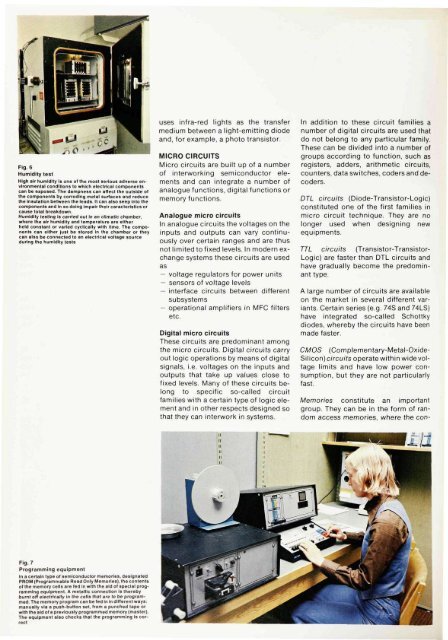Selection and Testing of Electronic Components for LM
Selection and Testing of Electronic Components for LM
Selection and Testing of Electronic Components for LM
Create successful ePaper yourself
Turn your PDF publications into a flip-book with our unique Google optimized e-Paper software.
Fig. 6<br />
Humidity test<br />
High air humidity Is one <strong>of</strong> the most serious adverse environmental<br />
conditions to which electrical components<br />
can be exposed. The dampness can affect the outside <strong>of</strong><br />
the components by corroding metal surfaces <strong>and</strong> reduce<br />
the Insulation between the leads. It can also seep Into the<br />
components <strong>and</strong> In so doing impair their caracterlstlcs or<br />
cause total breakdown.<br />
Humidity testing Is carried out in an climatic chamber,<br />
where the air humidity <strong>and</strong> temperature are either<br />
held constant or varied cyclically with time. The components<br />
can either just be stored In the chamber or they<br />
can also be connected to an electrical voltage source<br />
during the humidity tests<br />
Fig. 7<br />
Programming equipment<br />
In a certain type <strong>of</strong> semiconductor memories, designated<br />
PROM (Programmable Read Only Memories), the contents<br />
<strong>of</strong> the memory cells are fed In with the aid <strong>of</strong> special programming<br />
equipment A metallic connection is thereby<br />
burnt <strong>of</strong>f electrically in the cells that are to be programmed.<br />
The memory program can be fed in in different ways:<br />
manually via a push-button set, from a punched tape or<br />
with the aid <strong>of</strong> a previously programmed memory (master).<br />
The equipment also checks that the programming Is correct<br />
uses infra-red lights as the transfer<br />
medium between a light-emitting diode<br />
<strong>and</strong>, <strong>for</strong> example, a photo transistor.<br />
MICRO CIRCUITS<br />
Micro circuits are built up <strong>of</strong> a number<br />
<strong>of</strong> interworking semiconductor elements<br />
<strong>and</strong> can integrate a number <strong>of</strong><br />
analogue functions, digital functions or<br />
memory functions.<br />
Analogue micro circuits<br />
In analogue circuits the voltages on the<br />
inputs <strong>and</strong> outputs can vary continuously<br />
over certain ranges <strong>and</strong> are thus<br />
not limited to fixed levels. In modern exchange<br />
systems these circuits are used<br />
as<br />
— voltage regulators <strong>for</strong> power units<br />
— sensors <strong>of</strong> voltage levels<br />
— interface circuits between different<br />
subsystems<br />
— operational amplifiers in MFC filters<br />
etc.<br />
Digital micro circuits<br />
These circuits are predominant among<br />
the micro circuits. Digital circuits carry<br />
out logic operations by means <strong>of</strong> digital<br />
signals, i.e. voltages on the inputs <strong>and</strong><br />
outputs that take up values close to<br />
fixed levels. Many <strong>of</strong> these circuits belong<br />
to specific so-called circuit<br />
families with a certain type <strong>of</strong> logic element<br />
<strong>and</strong> in other respects designed so<br />
that they can interwork in systems.<br />
In addition to these circuit families a<br />
number <strong>of</strong> digital circuits are used that<br />
do not belong to any particular family.<br />
These can be divided into a number <strong>of</strong><br />
groups according to function, such as<br />
registers, adders, arithmetic circuits,<br />
counters, data switches, coders <strong>and</strong> decoders.<br />
DTL circuits (Diode-Transistor-Logic)<br />
constituted one <strong>of</strong> the first families in<br />
micro circuit technique. They are no<br />
longer used when designing new<br />
equipments.<br />
TTL circuits (Transistor-Transistor-<br />
Logic) are faster than DTL circuits <strong>and</strong><br />
have gradually become the predominant<br />
type.<br />
A large number <strong>of</strong> circuits are available<br />
on the market in several different variants.<br />
Certain series (e.g. 74S <strong>and</strong> 74LS)<br />
have integrated so-called Schottky<br />
diodes, whereby the circuits have been<br />
made faster.<br />
CMOS (Complementary-Metal-Oxide-<br />
Silicon) circuits operate within wide voltage<br />
limits <strong>and</strong> have low power consumption,<br />
but they are not particularly<br />
fast.<br />
Memories constitute an important<br />
group. They can be in the <strong>for</strong>m <strong>of</strong> r<strong>and</strong>om<br />
access memories, where the con-
















